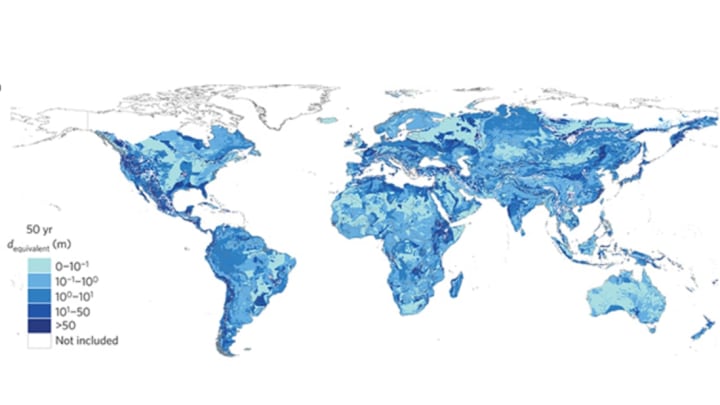Where’s All the Groundwater?

Rivers and streams aren't the only places we get water. Cities and farmers rely on groundwater pumped up from the water table that lies deep underground, especially in dry areas like the western United States. And there's an increasing need to know how much of it we have left. Dwindling groundwater supplies are a contentious issue in drought-ridden California, a state that just passed its first laws limiting the amount of water that can be pumped from underground aquifers. Now, researchers have mapped the global groundwater supplies for the first time in 40 years.
The new study, published in Nature Geoscience, estimates that less than 6 percent of the Earth’s groundwater stores is modern—that is, from the last 50 years. Other groundwater supplies are ancient, especially in deserts, dating back more than a million years. The researchers were focused on finding young stores of groundwater in the uppermost mile or so of the Earth’s crust, since those supplies might be more renewable than “fossil” groundwater, and also more vulnerable to contamination and disruption by agriculture, construction, and industry.
Let's take a slightly closer look at the groundwater distributions of North and South America. The darker the map color, the more groundwater a region has.
Places you might think of as dry, like Baja California or Chile's Atacama Desert, get most of their water supplies from deep groundwater stores. Meanwhile, places you think of as damp and rainy (see Scotland over on the top right) have relatively shallower groundwater stores. However, since so little of the groundwater stores are modern, that means they can't be renewed within a human lifetime.
"We already know that water levels in lots of aquifers are dropping," study co-author Tom Gleeson explains in a press release. "We're using our groundwater resources too fast—faster than they're being renewed."
"We find that groundwater replenished over a human lifetime of 25–100 years is a finite, limited resource,” the researchers write in the paper. Where it is distributed depends on geographical and geological conditions, and is subject to the whims of the water cycle. It’s the largest water resource on the planet, and we need to figure out how to use it wisely, before it runs dry and cannot be replenished for centuries.
All images from Gleeson et al., Nature Geoscience (2015)
The Afternoon Map is a semi-regular feature in which we post maps and infographics. In the afternoon. Semi-regularly.